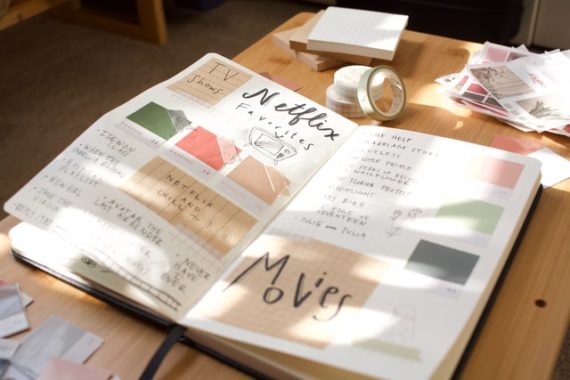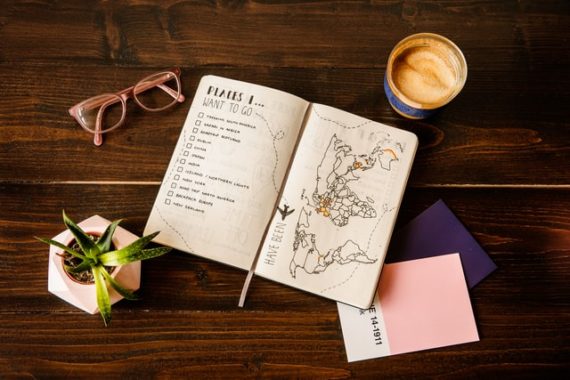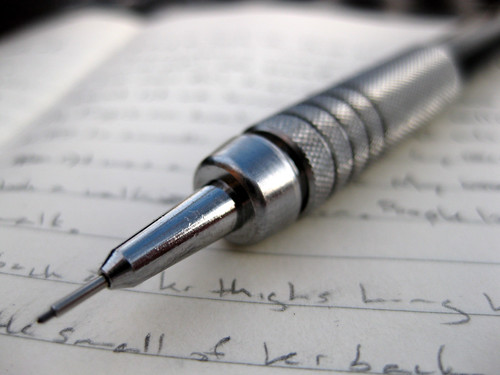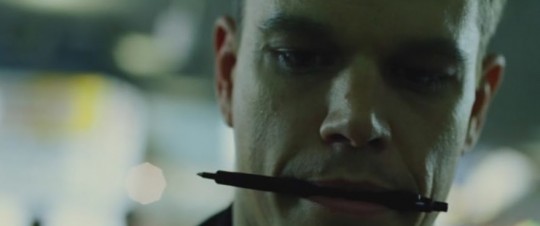How to Get Started with Bullet Journaling
Today: a guest blog post by Majo Meneses about getting started with bullet journaling.

Bullet journals are increasingly prevalent. If you’ve heard of people who use bullet journals to map out their lives, you’re probably curious about how to begin. It’s very simple. A bullet journal can be used for a variety of personal purposes, such as tracking your tasks, priorities, upcoming events or even the books you’re reading. Journaling can also serve as a way to deal with mental health illnesses and other health-related issues. To get started, here is all the information you’ll need to guide you through the whole process of creating your own bullet journal.
What Is a Bullet Journal?
Bullet journaling is a list-making, recording, and planning system with infinite possibilities for customizations. Though there are several options for bullet journals, many bullet journalists choose dot grid journals. These tiny dots provide structure while promoting freeform drawing and versatility. Bullet journaling has increased in popularity since its introduction in 2013, and social media websites like Pinterest and Instagram are places where people can showcase their impressive artwork.
Benefits of Keeping a Bullet Journal

The popularity of bullet journaling comes from its effectiveness. The method is easy to use and open to all – you don’t even need a graph paper notebook to get started. Bullet journaling may be done in a notebook, on loose sheets of paper, or with a collection of rainbow-coloured jelly pens. Get rid of all the planners you’ve never used and learn how bullet journaling can improve your life.
Easily customizable
Bullet journaling’s easily flexible style is one of its most appealing features. You can write down everything in your bullet journal instead of purchasing a different journal for your everyday logs, or a school calendar, or downloading a budget app, and scribbling grocery lists on pieces of paper. To match your own aesthetic, use stickers, washi tape, and bright pens.
Allows organization
Disorganization is no longer a problem for those who keep a bullet journal. To keep your life on track, create hourly, daily, weekly, and monthly pages, colour-code activities, make to-do lists, and jot down the book review you don’t want to miss –– all in one place.
Encourages productivity
There’s nothing like taking anything off your to-do list to make you feel accomplished. When you see the things you need to do in front of you, it motivates you to do them so you can move on to the next big thing. When you look back on what you accomplished during the week, you get a sense of satisfaction that is priceless.
Ideal for keeping lists
Who doesn’t like having a complete, organized to-do list? Simply open your bullet journal to a blank page and begin jotting down movies to watch, your favourite quotes, plants to plant in next year’s garden, and places to visit. Relevant information such as passwords, birthdays, and contact numbers should not be forgotten in case your phone fails.
Helps tracking long-term goals
Consider all of your long-term objectives and write them down in your bullet journal. Bullet journals make habit monitoring simple: create a calendar that lasts anything from a month to a year, and cross off each day that you complete a new habit. You can evaluate your performance at the end of your time span.
Enhances creativity
Bullet journaling promotes creativity in a way that other types of journaling do not. Create a customized template to celebrate each new month, play with calligraphy, or draw a mood storyboard. You’ll be shocked by how much fun you can have while creating your bullet journal, even if you don’t think of yourself as the creative type.
Key Supplies

Are you ready to begin your bullet journal journey? Setting yourself up for success is incredibly easy. All you need are a few basic items and you’ll be able to build the life of your dreams.
Journal
Quality paper, a faint dot grid, a durable front cover, and a back pocket for documents, receipts, and stickers are all features of the perfect bullet journal. Some papers often have bookmarks, which can be used to keep track of where you left off.
Pens
Choose your writing instruments. Bullet journal enthusiasts prefer fineliners, fountain pens, gel pens, brush pens, and highlighters. If you’re just getting started, start with a black pen, a few coloured pens, and a highlighter to see how they work.
Ruler
A ruler is useful for making straight lines and calendars. Since you can see where you’re drawing with see-through rulers, they’re a great option. For quick access, look for a ruler that fits into the pocket of your bullet book.
Stencils
Stencils are essential for maintaining a neat and symmetrical appearance in your bullet journal. There are numerous options available, ranging from circular habit trackers to uniform squares for creating regular and monthly calendars.
Washi Tape
One of bullet journalists’ favourite items is washi tape. These delightful rolls of tape come in an endless variety of colours, sizes, and patterns, making it easy to switch up the look of your journal. To keep your tape rolls sorted, consider investing in a wash tape dispenser.
Stickers
Stickers aren’t just for children, after all. Bullet journaling is taken to a new level with the addition of stickers. Decorate your pages with fun stickers to help you remember important dates and events while remaining efficient.
Sticky notes
Plans shift, and writing something down in ink can feel a bit too permanent at times. Here is where a sticky note comes in handy. Write down any potential dates or tentative plans on a sticky note and add it in your journal.
Stamps
It gets tedious to write and draw the same layout over and over again, so invest in some stamps to make creating regular and monthly spreads quicker and easier. They come in a variety of shapes, making it easy to personalize your bullet journal.
Pencil Case
You’ll be shocked by how quickly your array of pens and markers grows once you start buying them for your bullet journal. Consider buying a pencil case to keep all of your pens organized and accessible.
Watercolors
Watercolors are the perfect finishing touch to your lovely bullet journal. Portable watercolor sets make it easy to keep up with your regular sketch goals or add accents to calendars and lists when on the go.
Choosing the Layout for Your Bullet Journal

You can choose the types of spreads you want to use. What exactly do you want to capture? What do you want people to remember about you? Do you want to keep track of your accomplishments? Do you want to make a gratitude spread to help you be happier in your life? The bullet journal’s layout is built around these simple pages. Follow them, and you’ll be surprised at how much more productive you’ll be!
Index
The index should be placed at the very beginning of your bullet journal. You’ll have page numbers for all of your important documents, such as monthly calendars and sets, so you can quickly find what you need.
Future Log
Tasks, activities, goals, and appointments for the coming months are included in the future log. This is where you’ll keep track of long-term goals and goals that you want to accomplish.
Monthly Spread
The monthly spread includes a calendar and a job page to keep you organized for the month ahead. Begin planning the next month at the end of the current one, and keep track of any important dates in the future log.
Weekly Spread
Weekly spreads aren’t included in the original scheme, but they’re useful for organizing your week ahead. This is where you keep track of your appointments, deadlines, and goals. Weekly spreads are often used instead of monthly or regular spreads. Choose what works best for you!
Daily Spread
The daily spread is intended for use on a daily basis. Write the date as your subject at the top of your list, and then write down activities, events, and notes as they arise during the day.
Collections
Collections are a catch-all category for everything you want to put in your bullet journal that doesn’t fit into the other categories. You can use your journal to keep track of projects, priorities, brainstorming sessions, and lists.
Write away!
Bullet journaling is meant to be a convenient and enjoyable way to keep track of your day and get organized. Additionally, it becomes a fun, creative hobby, even if it may seem a bit too much to handle at the beginning. At the end of the day, it’s about you. So, look at your mistakes as opportunities to learn, be imaginative, and have some fun creating it. Your bullet journal can be whatever you want it to be.
How to Get Started with Bullet Journaling Read More »



